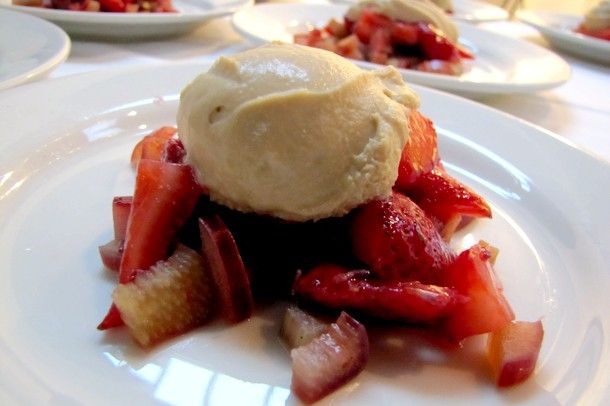Performance artist Keil Borrman
Saturday was the last official day of legal foie gras sales in California, celebrated through a number of foie-specific menus at restaurants as seemingly disparate as Beer Belly, which offered deep-fried foie Oreos, and The Royce, where chef David Feau prepared 30 courses with the delicacy over two days. At Culver City art space Royal/T, New York performance artist and food obsessive Keil Borrman debuted part two of “A History of Foie Gras and Its Ethics,” a rambling overview of the ingredient’s origins and present polemics attached to a menu designed for foie lovers, as well as an alternative, somewhat sadistic spread for vegetarians (“Part one” of Borrman’s performance was performed in Pennsylvania last August).
The start of our state’s foie prohibition was not commemorated by the liver being ceremoniously placed into a casket or falling from the sky, but in an exploration of foie’s place in historical diets and the ongoing controversy of its production, which stretches back to ancient Egypt.
Learning foie history from “self-professed expert” Borrman, who admitted his knowledge base is potentially “full of holes,” is a little like learning the facts of life from the playground, though it proved enlightening to hear him dispel the myths employed by foie’s biggest opponents, even as he insists he is “not for foie or against foie.”
To go along with his speech, Royal/T’s kitchen competently demonstrated the strengths of foie and its alternates, giving the ingredient a proper send-off. Come take a look at what we learned in our slideshow of Keil Borrman’s “History of Foie Gras and Its Ethics, Part Two.”
Borrman’s menu was broken into five dishes riffing on or including foie gras. The artist made a point that there are few big domestic markets for the ingredient outside of California and New York, meaning the ban was really having a negative impact on foie producers. In addition to foie gras being forbidden, Borrman stressed that duck breasts, fat for frying, and legs used for confit at restaurants often come from foie gras birds and would also be banned under the new law.
Were generally mistreated at the event, which handed them pink ducks to bear at their seats. Borrman attempted to make the vegetarian dishes recall the same things that geese and ducks are fed to make foie gras, with ample appearances from corn. While meat eaters were served at the table, the artist would routiney break his monologue to announce, “oh yeah, there’s a vegetarian dish in the back” and direct the meat-free to get up and get it themselves.
Borrman traces the origins of foie gras back to ancient Egypt where hieroglyphs were recently discovered depicting the practice of gavage. He says that Jewish slaves used goose fat to keep kosher and discovered that certain geese, like most migratory birds, were fattening themselves up for migration, producing the fatty liver that soon spread to the pharaoh creating “the demand of the oppressor”, through Turkey and ancient Rome, and eventually into France where an industry began. Foie geese used to be fed with figs before a switch was made to cheaper corn. Here Royal/T presents shaved foie torchon over toffed duck skin with brandied figs and cherries.
On the other side, vegetarians got red whole grains and cornmeal, mimicking the diet of gavage. One vegetarian was overheard saying, “this is torture.” Meanwhile, Borrman debunked the allegation that a foie gras liver is a diseased one, insisting that the enlarged liver naturally occurs in migratory waterfowl, who enlarge their own livers to ten-times the size before migrating. He also stressed that “force-feeding” is a term often employed by opponents, who overlook the fact that the animals can breathe naturally while being fed.
Seguing into a discussion of foie gras ethics, including the efforts of Hudson Valley Foie Gras,
Dan Barber, and Temple Grandin to create and approve of cruelty-free methods of production, Borrman offered this dish of monkfish liver, “the foie gras of the sea,” with scallop tartare. The artist also reminded the crowd that monkfish itself was overfished, noting the lack of an outcry or legislation.
This machaca-looking shredded meat was made from twelve individual duck legs and served with an uni panna cotta and jellied dashi. Foie gras’ U.S. roots, it was explained, started with German farmers who initiated production in Wisconsin.
Recieved a bowl of greens with Kix cereal, before being served with a bowl of noodles. “Noodling” is a practice where sausage-sized pellets of grain dough were dropped into the birds to make foie gras. We don’t know why vegetarians came to a foie gras dinner, but by this point, most of them had lost interest in Borrman’s rap and talked over him, muting his speech as it segued into an exploration of ethics.
Seared duck breast served with seared foie gras, with romaine.
Possibly the last bite of foie gras for a while, dessert involved a sea-salt, lavendar foie gras whipped cream over strawberries and rhubard with a smoked salt biscuit.
The restaurant’s kitchen crew, who prepared the five courses of foie gras with Borrman.
















